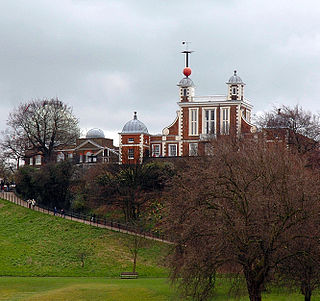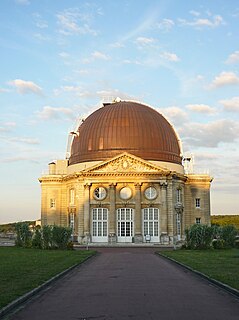
George Willis Ritchey was an American optician and telescope maker and astronomer born at Tuppers Plains, Ohio.

Yerkes Observatory is an astronomical observatory located in Williams Bay, Wisconsin, U.S.A. It was operated by the University of Chicago Department of Astronomy and Astrophysics from its founding in 1897 to 2020. Ownership was transferred to the non-profit Yerkes Future Foundation (YFF) in May 2020, which began restoration and renovation of the historic building and grounds. Re-opening for public tours and programming began May 27th, 2022.

The Mount Wilson Observatory (MWO) is an astronomical observatory in Los Angeles County, California, United States. The MWO is located on Mount Wilson, a 1,740-meter (5,710-foot) peak in the San Gabriel Mountains near Pasadena, northeast of Los Angeles.

Alvan Clark, born in Ashfield, Massachusetts, the descendant of a Cape Cod whaling family of English ancestry, was an American astronomer and telescope maker.

George Ellery Hale was an American solar astronomer, best known for his discovery of magnetic fields in sunspots, and as the leader or key figure in the planning or construction of several world-leading telescopes; namely, the 40-inch refracting telescope at Yerkes Observatory, 60-inch Hale reflecting telescope at Mount Wilson Observatory, 100-inch Hooker reflecting telescope at Mount Wilson, and the 200-inch Hale reflecting telescope at Palomar Observatory. He also played a key role in the foundation of the International Union for Cooperation in Solar Research and the National Research Council, and in developing the California Institute of Technology into a leading research university.

James Edward Keeler was an American astronomer. He was an early observer of galaxies using photography, as well as the first to show observationally that the rings of Saturn do not rotate as a solid body.

The Kodaikanal Solar Observatory is a solar observatory owned and operated by the Indian Institute of Astrophysics. It is on the southern tip of the Palani Hills 4 kilometres (2.5 mi) from Kodaikanal town.

Nancy Grace Roman was an American astronomer who made important contributions to stellar classification and motions. The first female executive at NASA, Roman served as NASA's first Chief of Astronomy throughout the 1960s and 1970s, establishing her as one of the "visionary founders of the US civilian space program". She created NASA's space astronomy program and is known to many as the "Mother of Hubble" for her foundational role in planning the Hubble Space Telescope. Throughout her career, Roman was also an active public speaker and educator, and an advocate for women in the sciences.

The Warner & Swasey Company was an American manufacturer of machine tools, instruments, and special machinery. It operated as an independent business firm, based in Cleveland, from its founding in 1880 until its acquisition in 1980. It was founded as a partnership in 1880 by Worcester Reed Warner (1846–1929) and Ambrose Swasey (1846–1937). The company was best known for two general types of products: astronomical telescopes and turret lathes. It also did a large amount of instrument work, such as equipment for astronomical observatories and military instruments The themes that united these various lines of business were the crafts of toolmaking and instrument-making, which have often overlapped technologically. In the decades after World War II, it also entered the heavy equipment industry with its acquisition of the Gradall brand.

Alvan Clark & Sons was an American maker of optics that became famous for crafting lenses for some of the largest refracting telescopes of the 19th and early 20th centuries. Founded in 1846 in Cambridgeport, Massachusetts, by Alvan Clark, and his sons George Bassett Clark (1827–1891) and Alvan Graham Clark (1832–1897). Five times, the firm built the largest refracting telescopes in the world. The Clark firm gained "worldwide fame and distribution", wrote one author on astronomy in 1899.
1024 Hale, provisional designation A923 YO13, is a carbonaceous background asteroid from the outer regions of the asteroid belt, approximately 45 kilometers (28 miles) in diameter. The asteroid was discovered on 2 December 1923, by Belgian–American astronomer George Van Biesbroeck at the Yerkes Observatory in Wisconsin, United States. It was named for American astronomer George Ellery Hale. The dark C-type asteroid may have a rotation period of 16 hours.

The University of Illinois Astronomical Observatory, located at 901 S. Mathews Avenue in Urbana, Illinois, on the campus of the University of Illinois Urbana-Champaign, was built in 1896, and was designed by Charles A. Gunn. It has been listed on the National Register of Historic Places since November 6, 1986, and on December 20, 1989, was designated a National Historic Landmark.

McMillin Observatory was an astronomical observatory built around 1895 on the campus of Ohio State University. Named after Emerson McMillin and operated by the university, the observatory closed in 1968 and its telescope later moved to Ballreich Observatory. The observatory was equipped with photographic cameras, a filar micrometer, and a custom Brashear spectroscope. The observatory had two main focuses, education and at least one astronomic scientific research study focus.

Great refractor refers to a large telescope with a lens, usually the largest refractor at an observatory with an equatorial mount. The preeminence and success of this style in observational astronomy defines an era in modern telescopy in the 19th and early 20th century. Great refractors were large refracting telescopes using achromatic lenses. They were often the largest in the world, or largest in a region. Despite typical designs having smaller apertures than reflectors, great refractors offered a number of advantages and were popular for astronomy. It was also popular to exhibit large refractors at international exhibits, and examples of this include the Trophy Telescope at the 1851 Great Exhibition, and the Yerkes Great Refractor at the 1893 World's Fair in Chicago.

The Shuckburgh telescope or Shuckburgh equatorial refracting telescope was a 4.1 inches (10.4 cm) diameter aperture telescope on an equatorial mount completed in 1791 for Sir George Shuckburgh (1751–1804) in Warwickshire, England, and built by British instrument maker Jesse Ramsden (1735–1800). It was transferred to the Royal Observatory, Greenwich in 1811 and the London Science Museum in 1929. Even though it has sometimes not been regarded as particularly successful, its design was influential. It was one of the larger achromatic doublet telescopes at the time, and one of the largest to have an equatorial mount. It was also known as the eastern equatorial for its location.
The Lamont–Hussey Observatory (LHO) was an astronomical observatory owned and operated by the University of Michigan (UM). It was located in the city of Bloemfontein, Free State, South Africa. Construction at the site began in 1927, and the facility was closed in 1972.

Yerkes 41-inch reflector is a 40-inch aperture (101.6 cm) reflecting telescope at the Yerkes Observatory, that was completed in 1968. It is known as the 41 inch to avoid confusion with a 40 inch refractor at the observatory. Optically it is a Ritchey–Chrétien design, and the main mirror uses low expansion glass. The telescope was used as a testbed for an adaptive optics system in the 1990s.

Sheepshanks equatorial was a 6.7 inch (170 mm) aperture refracting telescope installed in 1838 at the Royal Observatory in Greenwich. The telescope was donated to the observatory by the astronomer Richard Sheepshanks. The telescope had a doublet objective lens made by Cauchoix of Paris. Originally it was mounted on a clockwork driven equatorial mounting by Grubb Parsons on a stone pillar.

Meudon Great Refractor is a double telescope with lenses, in Meudon, France. It is a twin refracting telescope built in 1891, with one visual and one photographic, on a single square-tube together on an equatorial mount, inside a dome. The Refractor was built for the Meudon Observatory, and is the largest double doublet refracting telescope in Europe, but about the same size as several telescopes in this period, when this style of telescope was popular. Other large telescopes of a similar type include the James Lick telescope (91.4), Potsdam Great Refractor (80+50 cm), and the Greenwich 28 inch refractor (71.1 cm).
















